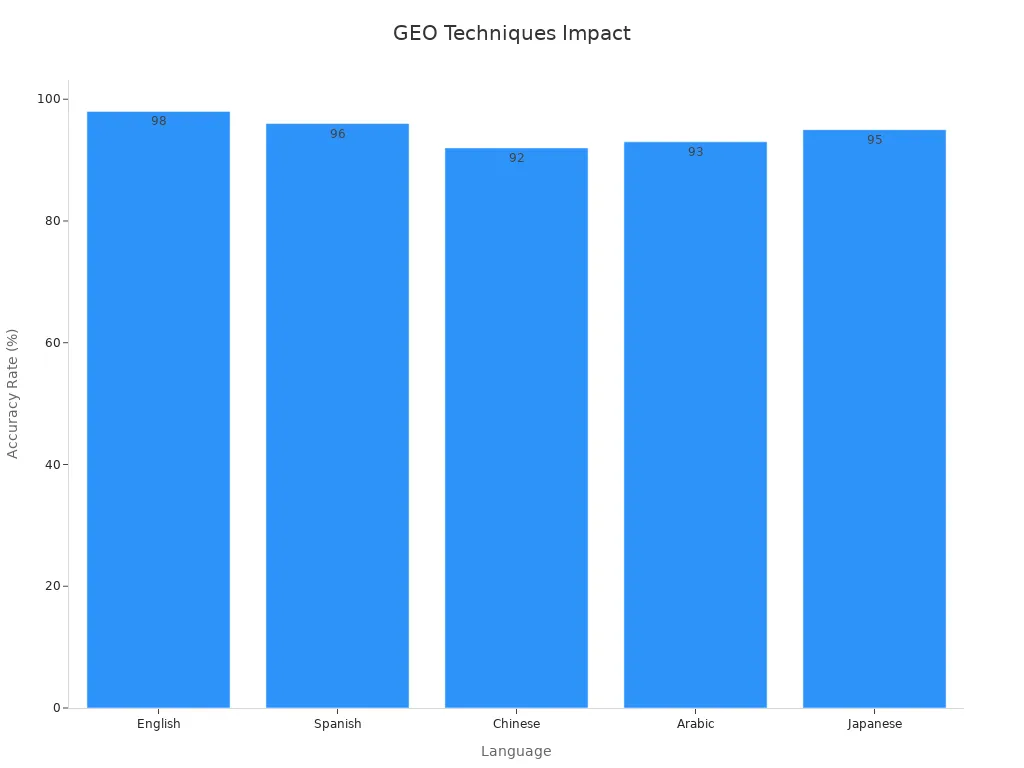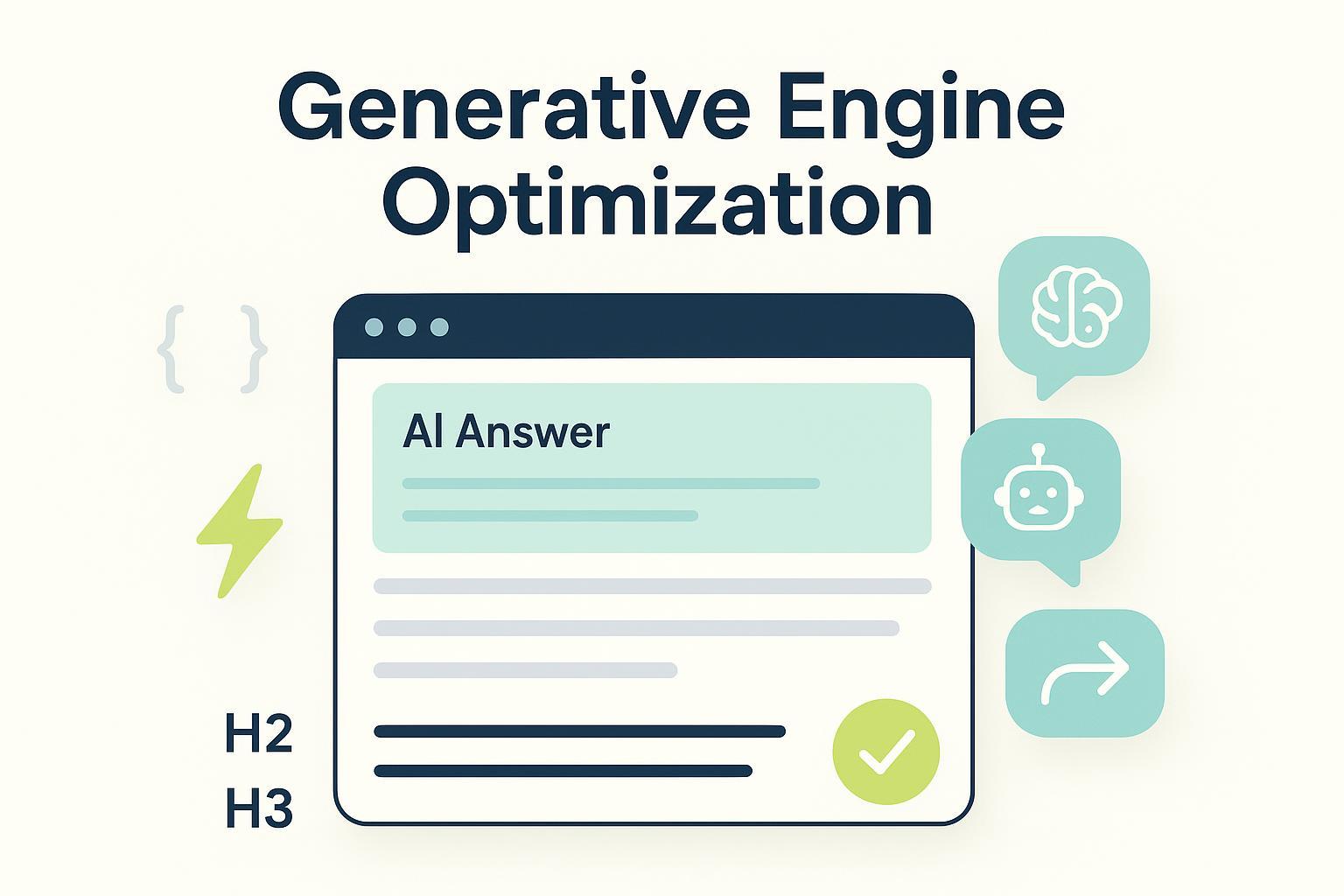Top Techniques to Optimize Multilingual GEO for AI Platforms
Optimize multilingual GEO for AI platforms with localization, SEO, and generative AI techniques to boost global visibility and user engagement.


Expanding your AI platform to many languages is very important today, especially in a Multilingual GEO context. It helps you reach different people and make your content meaningful across various regions. Optimizing for many languages improves visibility and enhances search results.
The numbers prove this. The AI language translation market is growing fast and may reach $4.5 billion by 2033. Apps like Duolingo saw 30% more user activity after using AI for learning, highlighting the significance of a Multilingual GEO approach. These facts show how AI helps connect locally and globally.
Using a location-based blogging plan with AI can help you create content that fits different language groups within a Multilingual GEO framework. This keeps your platform strong and useful in the ever-changing digital world.
Key Takeaways
Adding more languages to your AI platform helps more people see and use it, which is important for reaching users worldwide.
Using multilingual SEO makes your platform show up higher in search results, bringing in more users and boosting sales.
Skipping multilingual optimization can hurt your results and stop your platform from reaching people who don’t speak English.
AI tools can help you translate content and find good keywords faster and more accurately, making sure your content fits local users.
Updating your content often and checking how it performs keeps your strategies working well and meeting what users want.
Why Multilingual GEO Matters for AI Platforms

Benefits of Multilingual GEO in AI-Driven Search
Multilingual GEO is key to making AI platforms work better. Adding many languages helps break language barriers and improves communication worldwide. AI tools for transcription and translation make tasks easier, like managing video evidence. For example:
In global cases, AI tools analyze videos with different languages.
These tools help teams speaking different languages work together smoothly.
Police and legal teams solve cases faster without language problems.
When you focus on multilingual GEO, your AI platform becomes easier to use. This makes users happier and helps your platform grow globally.
Competitive Advantage Through Multilingual SEO
Multilingual SEO gives your AI platform a big advantage online. It helps you reach more people and rank higher in searches. Here’s how it helps:
Multilingual SEO makes content fit local languages and cultures.
It increases sales by matching what people in other countries want.
Search engines reward platforms with good multilingual SEO, making them easier to find.
Using multilingual SEO makes your platform a leader in global markets. It keeps you ahead of others who only use one language.
Challenges of Ignoring Multilingual GEO Optimization
Skipping multilingual GEO optimization can hurt your AI platform. Studies show using only English data causes problems for other languages. Languages with fewer resources face more mistakes or unfair results.
Problem | What Happens |
|---|---|
English-only data causes bad results in other languages. | Non-English users face more risks. |
No multilingual safety leads to harm. | Some groups get less access to fair AI. |
Ignoring multilingual GEO limits your platform’s reach and can harm users. To be fair and include everyone, you need to focus on multilingual strategies.
Key Techniques for Multilingual GEO Optimization
Content Localization and Translation Strategies
Making content fit local needs is key for success. You must adjust your content to connect with different groups while keeping its main idea. AI translation tools make this faster and more accurate. Businesses using these tools save time without losing quality.
Localization is more than just translating words. It means changing images and text to match local cultures. Companies that do this often keep 20% more users. Advanced tools for managing translations can speed up the process by 30% compared to older methods.
To keep your content working well, track things like clicks and sales. Using methods like back-translation and testing with small groups can improve your message. Following local rules for design and laws also makes your platform more appealing worldwide.
Technical Optimization for Multilingual GEO
Fixing technical issues helps multilingual platforms work better. AI platforms need tools that handle many languages easily. For example, real-time data checks show how content is doing and what to fix. Multilingual features let you test content in different languages to reach more people.
Adding internal links is also important. It helps users move around your site and improves search rankings. Tools that score quality give tips on keywords and trust-building, helping you improve your site.
AI translation tools do more than just translate. They create content that fits local cultures, add SEO tags, and make global content ready for search engines. A tech blog that used new data and trusted sources got more visitors from Bing Chat, showing how good technical fixes help.
Feature | Benefit |
|---|---|
Real-time Data Analysis | Check content performance and find fixes. |
Multilingual Support | Test content in many languages to reach more. |
Internal Link Integration | Help users navigate and improve search rank. |
Quality Scoring | Get tips on keywords and trust-building. |
Generative AI Engine Optimization Techniques
Improving generative AI engines boosts multilingual platform success. Adjusting strategies for each content type helps it rank higher. For example, adding facts and sources makes factual content stand out. Historical content does well with quotes, and business content improves with clear writing.
AI tools can also make your work easier by automating tasks. They create content that fits local cultures, keep your brand voice steady, and improve SEO for different regions. Using generative AI helps you connect with more people and rank higher in searches.
Content Type | Optimization Strategy | Visibility Improvement |
|---|---|---|
Debate/Opinion | Use a strong, clear tone | Better visibility |
Factual | Add facts and sources | Top search results |
Historical | Include quotes | Best performance |
Business | Focus on clear writing | Strong results |
To stay ahead, keep improving based on data. Generative AI tools let you adjust to new trends, keeping your platform competitive worldwide.
Keyword Research for Multilingual Audiences
Finding the right keywords is very important for your AI platform. It helps you know what people in different places are searching for. This way, your content can match their needs. Without good research, your platform might not connect with local users. This could stop it from growing worldwide.
Why Keyword Research Matters in Multilingual GEO
When reaching multilingual users, think about how language and culture affect searches. A word that works in one place might not work in another. For example, people in Spain may search "coches eléctricos," but in Mexico, they use "autos eléctricos." Knowing these differences helps your content show up in the right searches.
Localized keyword research finds these differences. It helps you make content that fits what people in certain areas want. This makes your platform easier to find and more engaging in different regions.
Steps to Conduct Effective Localized Keyword Research
Follow these steps to do better in multilingual GEO optimization:
Use AI-Powered Tools
AI tools make finding keywords in many languages easier. They check search trends, suggest local terms, and even predict new topics. Tools like Google Keyword Planner and SEMrush support multiple languages, saving you time.Analyze Competitor Strategies
Look at what your competitors are doing in the same region. Find out which keywords they use and adapt them for your platform. This helps you find gaps in their strategy and use them to your advantage.Leverage Local Insights
Work with local experts or native speakers to improve your keyword list. They can add cultural context and suggest terms that feel natural to the audience. This makes your content more relatable and effective.Focus on Long-Tail Keywords
Long-tail keywords are more specific and often have less competition. For example, instead of "AI tools," try "AI tools for small businesses in Germany." These phrases attract users with clear goals.Test and Refine Regularly
Keyword trends change over time. Check your performance data and adjust your plan as needed. AI tools can help you see which keywords bring traffic and conversions.
How AI Enhances Keyword Research
AI makes keyword research faster and smarter. It handles large amounts of data to find patterns and trends. For multilingual GEO, AI can:
Translate keywords correctly while keeping their meaning.
Suggest similar words for different languages.
Study user behavior to guess future search trends.
Using AI saves time and improves your research accuracy. This keeps your platform strong in different markets.
Common Pitfalls to Avoid
Avoid these mistakes when doing keyword research for multilingual users:
Mistake | Impact |
|---|---|
Using direct translations | Keywords may lose meaning or value. |
Ignoring cultural nuances | Content may not connect with users. |
Overlooking long-tail terms | Missed chances for specific traffic. |
By fixing these issues, you can build a strong keyword plan that works well.
Pro Tip: Focus on what users want, not just search numbers. A smaller, more relevant keyword can bring better results.
Tools and Technologies for Multilingual GEO Optimization
AI-Powered Content Creation Tools
AI tools change how we make content for many languages. They study what users want and adjust to meet their needs. Unlike old methods, AI understands context and tests different content ideas.
Feature | AI Tools | Old Methods |
|---|---|---|
Understand User Needs | Yes | No |
Match Context | High | Low |
Adjust Quickly | Yes | Limited |
Check Sentiment | Yes | No |
Map User Intent | Yes | No |
Test Content Ideas | Yes | No |
AI also makes content more personal by changing tone and style. It ensures your platform connects with people worldwide. Using AI saves time and makes your multilingual SEO better and faster.
Localization and Translation Platforms
Localization platforms help adapt content for different languages and cultures. They do more than just translate words. These tools make sure your content fits local customs. For example, one company translated millions of words into 36 languages, saving 28% in costs.
Other examples show how helpful these platforms are:
A Fintech company translated articles, gaining 10,000 views on key content.
EasyTranslate’s HumanAI made translations 10 times faster and cut costs by 90%.
Tasks that took 20 hours now take only 2 hours.
HumanAI made just one mistake per 1,000 words, beating old methods.
These platforms work well with AI tools. They help you create accurate and culturally relevant content for global audiences.
Performance Monitoring and Analytics Tools
Tracking tools measure how well your multilingual strategies work. They check traffic, engagement, and sales in different languages. This data shows where to improve and how to adjust your plan.
AI-powered tools give even deeper insights. They show how users interact with your content and suggest changes. For example, they can find which hreflang tags boost search rankings or which areas need more focus.
Using these tools keeps your multilingual SEO strong. Regular checks help you stay updated and compete in global markets.
Testing and Measuring Multilingual GEO Success
Metrics for Evaluating Optimization Effectiveness
To check how well your multilingual GEO strategies work, track specific metrics. These metrics show how your platform performs in different areas and languages. Below is a table of key metrics and why they matter:
Metric | Description | Importance | Optimization Strategies |
|---|---|---|---|
Average cost to gain a new customer in a region. | Shows how campaigns work locally. | Compare CAC with local media costs and try different channels. | |
Regional Conversion Rate per Channel | Percentage of leads turned into customers by area and channel. | Finds top-performing channels in regions. | Test messages and offers that fit local needs. |
Lead-to-Customer Rate by Region | Number of leads that become paying customers in a region. | Points out problems in specific areas. | Use tools to predict which leads will convert best. |
Regional Engagement Metrics | Measures how users interact with your site or app in regions. | Low engagement shows content isn’t working. | Adjust pages to match local languages and cultures. |
Social Media Engagement & Sentiment Analysis | Tracks likes, shares, comments, and feelings on social platforms. | Measures brand awareness in regions. | Use tools to study emotions in local languages. |
Market Penetration Rate by Region | Percentage of potential customers gained in a region. | Shows market growth and maturity. | Mix market research with sales data for better insights. |
By tracking these metrics, you can make sure your strategies meet local needs and improve your platform globally.
Methods for Testing Content Across Languages
Testing content in different languages helps your platform connect with many audiences. Here are some ways to test content effectively:
Methodology | Description |
|---|---|
Show different versions of content to groups and compare results. | |
Data Analysis | Use tools to study test results and find patterns in performance. |
Refinement | Use AI tools to improve content based on test findings. |
Human-in-the-Loop | Check user feedback like satisfaction and acceptance rates. |
User-Centric Testing | Focus on how users feel about interactions to meet their needs. |
For example, A/B testing lets you try different messages for local audiences. AI tools then study the results to find what works best. Using these methods ensures your content fits well with various languages and cultures.
Iterative Improvements Based on Data Insights
Improving your strategies over time is important for multilingual GEO success. By studying data, you can adjust your plans to meet changing user needs. Here are some proven methods:
Multilingual arbitrage boosts success rates by 56.5% across all languages.
Fixed routing models improve multilingual tasks by 2.50%.
Reward-based routing increases results by 56.1% for medium-resource languages.
Real-time data helps create feedback loops. These loops show where your content needs improvement and suggest changes for local audiences. For example, AI tools can study how localized content performs and recommend updates based on user actions. This ongoing process keeps your platform strong in global markets.
Pro Tip: Use data trends to regularly update your strategies and stay ahead in multilingual GEO optimization.
Staying Ahead of Multilingual GEO Trends
New Trends in Generative AI Optimization
Generative AI is changing how content works with search engines. Unlike old SEO, which focuses on rankings, generative optimization (GEO) helps AI understand your content better. This is important for showing up in AI summaries and chat searches. Adding facts, quotes, and strong language makes your content more useful.
Aspect | Visibility Impact |
|---|---|
Traditional SEO | No major effect |
Generative Optimization (GEO) |
To compete, make your content easy for AI to read and use. Organize information clearly so AI can share it correctly. This helps your platform show up more in AI-driven searches, even when users skip direct links.
Keeping Up with AI Updates
AI systems like fresh, updated content. Regular updates keep your platform ready for new user questions. This is very important for multilingual GEO, where accuracy in all languages matters. Updating often also helps AI combine information better, improving your global reach.
To adjust, create content that changes with user needs. Watch for AI updates and change your strategies as needed. For example, update local keywords or fix old content to match AI rules. Staying active keeps your content visible and effective.
Learning and Trying New Ideas
AI changes fast, so learning is key. Testing helps you find what works best. For example, try A/B testing to see how different content works in various languages. AI tools can study the results and give tips to improve your multilingual GEO.
Use feedback to make your content better. Real-time data shows what needs fixing, so you can improve step by step. This helps your platform grow globally and stay ready for future changes. By always learning, you can succeed in the multilingual GEO world.
Making your AI platform work in many languages opens global doors. It helps you reach different people, improves user experience, and makes your platform easier to find worldwide. The methods shared—localization, fixing technical issues, using generative AI, and finding the right keywords—help you create content that connects with users everywhere.
These strategies show great results in accuracy across languages. For example, platforms using multilingual GEO methods report these success rates:
Language | Accuracy Rate |
|---|---|
English | 98% |
Spanish | 96% |
Chinese | 92% |
Arabic | 93% |
Japanese | 95% |

Using AI tools and data tracking, you can improve your plans and stay updated. These techniques not only make your platform stronger but also help it succeed in a tough global market. Start improving now and see your AI platform grow like never before.
FAQ
1. What is Multilingual GEO optimization?
Multilingual GEO optimization means making your AI platform work well in different languages and regions. It helps your content show up higher in local searches, reach more people, and improve user experience worldwide.
Tip: Use localization and technical fixes to expand your platform’s reach.
2. How can AI tools help with keyword research?
AI tools study search trends, find local keywords, and predict new topics. They save time by automating the process and ensuring accuracy in many languages. This helps you create content that fits what local users want.
Pro Tip: Try AI tools like SEMrush or Google Keyword Planner for multilingual keyword ideas.
3. Why is localization more than translation?
Localization changes content to match cultural habits, preferences, and rules. It also adjusts images, tone, and messages to connect better with local users. This builds trust and keeps people interested.
Note: Localization keeps 20% more users compared to just translating.
4. What metrics should you track for multilingual GEO success?
Watch metrics like conversion rates and engagement levels to see how your strategies work in different languages and regions.
Metric | Why It Matters |
|---|---|
Conversion Rate | Shows campaign success |
Engagement Metrics | Tracks user interaction |
5. How often should you update multilingual content?
Update your content often to meet changing user needs and AI updates. Regular updates keep your content accurate and visible in global searches.
Alert: Old content lowers search rankings and trust. Keep it fresh and useful.
See Also
Strategies for Excelling in AI Search Optimization 2025
The Impact of OpenAI’s Search Tool on GEO
Understanding Generative Engine Optimization: A Comprehensive Guide
Comparing GEO and AEO: Essential Differences Explained
Steps to Effectively Implement Generative Engine Optimization





